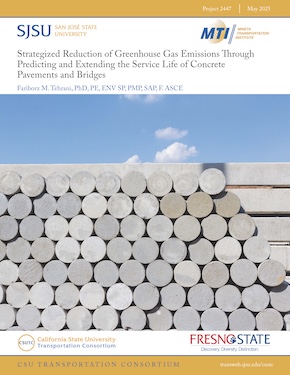- 408-924-7560
- mineta-institute@sjsu.edu
- Donate
Strategized Reduction of Greenhouse Gas Emissions Through Predicting and Extending the Service Life of Concrete Pavements and Bridges
Strong, durable concrete is key to resilient, long-lasting transportation infrastructure—especially in the face of climate change. This project explores innovative strategies for predicting and enhancing the service life of concrete in pavement and bridge systems, addressing the pressing need for sustainable transportation infrastructure. As concrete is pivotal to the durability and resilience of such structures, its environmental impact demands urgent attention. This project aims to reduce greenhouse gas emissions throughout their lifecycle by extending the service life of concrete pavements and bridge decks. A significant focus of the research is on the indications of chloride ion penetration in concrete, which is critical in controlling corrosion of steel reinforcing bars and keeping the infrastructure reliable. This project proposes the integration of lightweight aggregates, which have shown promise in improving the impermeability and resistance to chloride ion penetrations, which can occur through external sources such as seawater and de-icing salts. The findings provide the transportation industry with best practices and guidelines for implementing sustainable material choices while optimizing the performance of concrete structures, thereby contributing to more resilient and environmentally friendly practices that keep American infrastructure safe for moving people and goods.
Prof. Dr. Fariborz M. Tehrani, PhD, PE, ENV SP, PMP, SAP, FASCE
Dr. Fariborz M. Tehrani is a Professor and Director with nearly four decades of academic and industry background in engineering design, management, education, and leadership. His research and practice experiences focus on sustainable and resilient structural engineering, mechanics, and materials (SR-SEMM). Fariborz is a Fellow ASCE, the Director of the ESCSI, a voting member of several ACI, ASTM, and TRB Committees, the EMI’s Liaison in the ASCE Sustainability Task Committee, and the Vice Chair of EMI Objective Resilience Committee. He has also served as the ISI Academic Committee Chair and EWB professional mentor in USC, UCSD, and Cal Poly SLO. He has over 100 published and over 120 presented scholarly works. Dr. Tehrani received the 2015 ASCE Region 9 Outstanding Faculty Advisor Award, the 2017 CHESC Best Practice Award, and two 2019 ASCE Research Awards from Fresno and San Francisco for two projects. He received his BSc from Sharif University of Technology, his MSc from Amirkabir University of Technology, and his MS, Degree of Engineering, and PhD from the University of California, Los Angeles.
-
Contact Us
San José State University One Washington Square, San Jose, CA 95192 Phone: 408-924-7560 Email: mineta-institute@sjsu.edu






